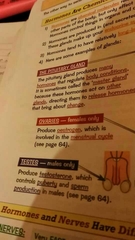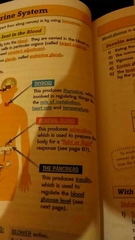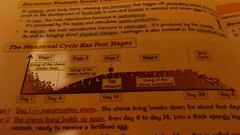![]()
![]()
![]()
Use LEFT and RIGHT arrow keys to navigate between flashcards;
Use UP and DOWN arrow keys to flip the card;
H to show hint;
A reads text to speech;
38 Cards in this Set
- Front
- Back
|
What is homeostasis |
Maintaining a stable internal environment |
|
|
Why does homeostasis happen |
Conditions in the body need to be kept steady even when the external environment changes. Cells Need right conditions to function including right conditions for enzyme action |
|
|
What do you have in your body for homeostasis |
Loads of automatic control systems to regulate your internal environment, including nervous and hormonal communication systems. There are control systems that maintain your body temperature, blood glucose levels and your water content . |
|
|
What are automatic control systems made of |
Three components which work together to maintain stable conditions. cells called receptors, coordination centres and effectors |
|
|
Name some coordination centres |
The brain,spinal cord and pancreas |
|
|
What is negative feedback |
Automatic control systems mechanism of bringing levels of something back too normal if they are too high or low . |
|
|
What is the process of negative feedback |
1) receptor detects a stimulus level is too high/low 2) Coordination Centre receives and processes information, organises a response 3)Effector produces a response which counteracts the change and restores the optimum level, the level increases/decreases 4) Effectors carry on producing responses for as long as they are stimulated by the coordination centre. If the levels get too high, receptors detect this and negative feedback begins again. |
|
|
How do Effectors respond to nerves impulses |
Muscles contract and glands release hormones |
|
|
What is the central nervous system CNS |
Coordinates response for effector to carry out in the nervous system, it is the coordination centre |
|
|
How does the nervous system do negative feedback |
1 Receptors detects stimuli 2 Coordination Centre CNS receives a electrical impulse from sensory neurons, processes information and organises response 3 electric impulse down motor neurones to effectors, which carry out response |
|
|
Describe reflex arc |
1 stimulus detected by receptors, impulse sent along sensory neurones to relay neurone in the CNS 2 impulse reaches synapse bettwen sensory neurones and relay neurones releasing chemicals 3 Impulses travel down relay neurons which reaches synapse between motor neurons, releasing chemicals 4 electrical impulse travels along motor neurons to effector, which causes usually a muscle to contract |
|
|
What is a relay neurone |
Connects sensory neurones to motor neurons, |
|
|
What is the endocrine system |
Other way to send information around body by using hormones |
|
|
What releases hormones |
Glands |
|
|
What is the master gland |
The pituitary gland, it is the master gland as it it's hormones instruct other glands to release hormones |
|
|
Name three glands and there purposes |

|
|
|
Name another three glands and there purpose |

|
|
|
What happens if blood glucose levels are too high |
Pancreas releases insulin and then insulin makes the liver turn the glucose in the blood into glycogen |
|
|
What happens if blood glucose levels are too low |
Pancreas releases glucagon which makes liver turn glycogen into glucose |
|
|
What is type 1 and type 2 diabetes |
Type1 body produces little or no insulin Type 2 when body cells become resistant to insulin |
|
|
Why does your body release sex hormones. |
To trigger secondary sexual characteristics like facial hair for males and breasts for females. They also cause eggs to mature in women. |
|
|
What is the main reproductive hormone in males |
Testosterone. Produced by the testes and stimulates sperm production. |
|
|
What is the main reproductive hormone in females |
Oestrogen. It is produced by the ovaries. Brings physical changes and is involved in the menstrual cycle. |
|
|
How many stages does the menstrual cycle have |
4 |
|
|
Menstrual cycle picture |

|
|
|
describe Menstrual stages |
Stage1 day 1 menstruation starts. Uterus lining breaks down for about 4 days Stage2 uterus lining builds up again, from day 4 to day14 , into a spongy layer of blood vessels, to receive a fertilised egg Stage3 an egg is developed and is released from the overy at day 14, this is called ovulation Stage 4 the wall is then maintained for about 14 days to 28 days. If no fertilised egg has landed on the wall by day 28, the spongy lining starts to break down and the whole cycle starts again |
|
|
How many hormones are the menstrual cycle controlled by? And what are they |
4 Oestrogen FSH follicule stimulating hormone LH luteinising hormone Progesterone |
|
|
Describe FSH(stage 1) |
Produced in the pituitary gland Causes egg to mature in overies, in a structure called a follicule Stimulates the ovaries to produce oestrogen |
|
|
Describe oestrogen (stage 2) |
Produced in the ovaries Causes lining of the uterus to grow Stimulates the release of LH (which causes the release of an egg) and stops release of FSH |
|
|
Describe LH (stage 3) |
Produced by the pituitary gland Stimulates the release of an egg at day 14 (ovulation) |
|
|
Describe progesterone (stage 4) |
Produced in the overies by the remains of the follicle after ovulation. Maintains the lining of the uterus during the second half of the cycle. When the level of progesterone falls, the lining breaks down. Stops the release of LH and FSH |
|
|
What hormones can reduce fertility |
High levels of oestrogen stops the production of FSH, then egg development and production stops Progesterone stimulates the production of thick mucus, prevents all sperm from reaching egg The pill contains progesterone and oestrogen,99% effective, does have bad side effects(headaches and nausea)
Progesterone only pill has fewer side effects and is just as effective Contraceptive patch contains oestrogen and progesterone, each patch lasts a week Contraceptive implant , continuous release of progesterone, stops overies from releasing eggs, implant can last for 3 years Contraceptive injection contains progesterone , lasts 2 to 3 months |
|
|
Non hormonal barriers |
Stop sperm from reaching egg Condoms Diaphragm, plastic cup fitted in cervix(entrace to uterus), used with spermicide Spermicide on its own is 70 to 80 percent effect |
|
|
More drastic ways to avoid pregnancy |
Sterilisation cutting or tying the fallopian tubes (connects the overies to the uterus) or (tubes which connect testes and penis) Natural Methods- finding out when the Menstrual cycle is most fertile and avoiding sexual intercourse on this Day Abstinence- not having intercourse |
|
|
How are hormones used to increase fertility? |
Some women have low FSH, SO FSH and LH can be given to stimulate ovulation. Could result in too many eggs and more babies, may have to be done multiple times to get a baby so can be expensive |
|
|
What is IVF |
in vitro fertilisation Collecting eggs and fertilising them in a lab with a males sperm. Can involve intra cytoplasmic sperm injection (ICSI) to directly inject sperm if there is a low amount of sperm Eggs are grown into embryos in a laboratory incubator One or two of the embryos are placed in uterus to improve chance of pregnancy. This process can give a infertile couple a child. |
|
|
What are the negatives of IVF |
Multiple births meaning could result in miscarriage
Success rate is 26%
Emotionaly and physically stressful, strong reactions to hormones could create abdominal pain, vomiting and dehydration. Wasted embroys destroyed, ethical problems |
|
|
Thyroxine and TSH |
Thyroid stimulating hormone is released from the pituitary gland. When the levels of thyroxine in the blood is higher than normal, the secretion of TSH from.pituitary gland is stopped. This reduces the amount of thyroxine released from the thyroid gland , so the level in the blood falls back towards normal. |

